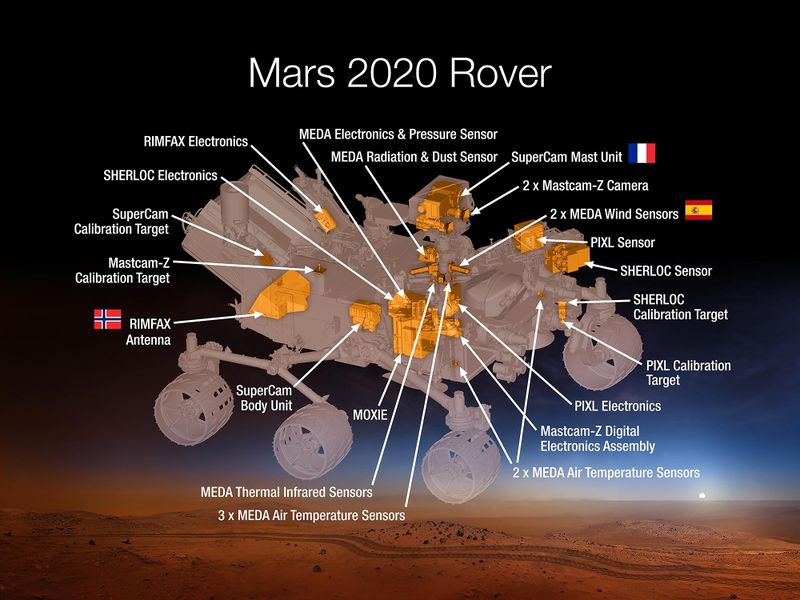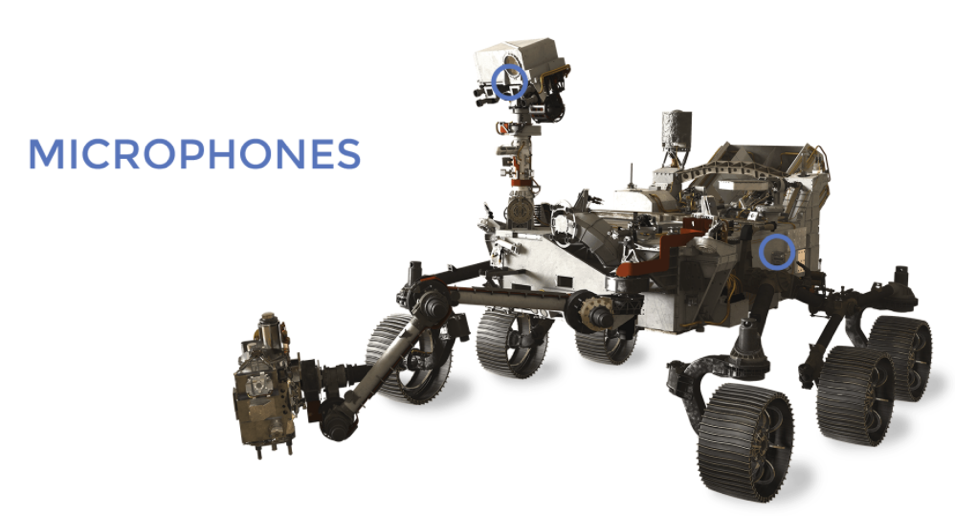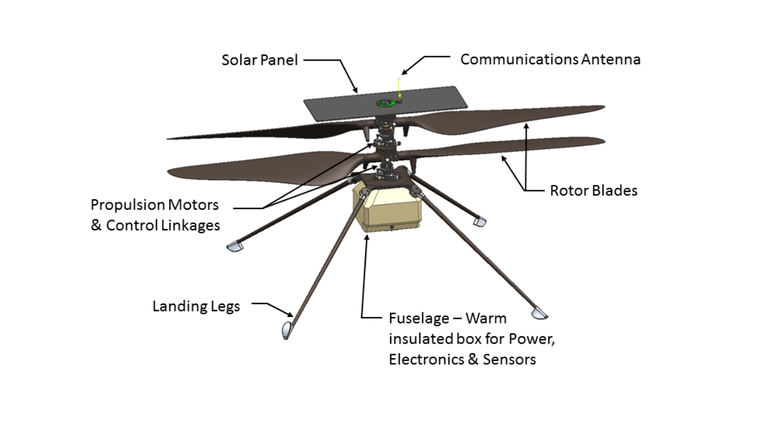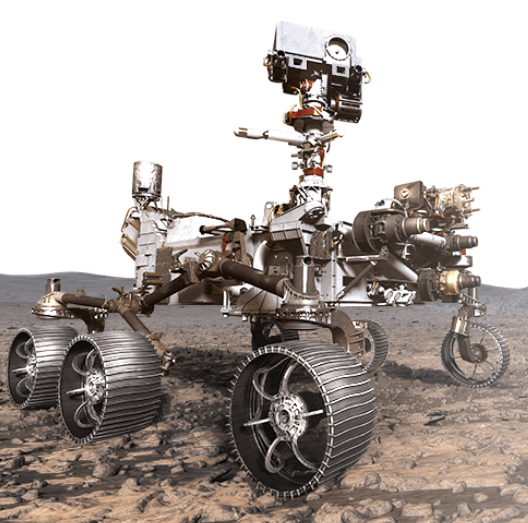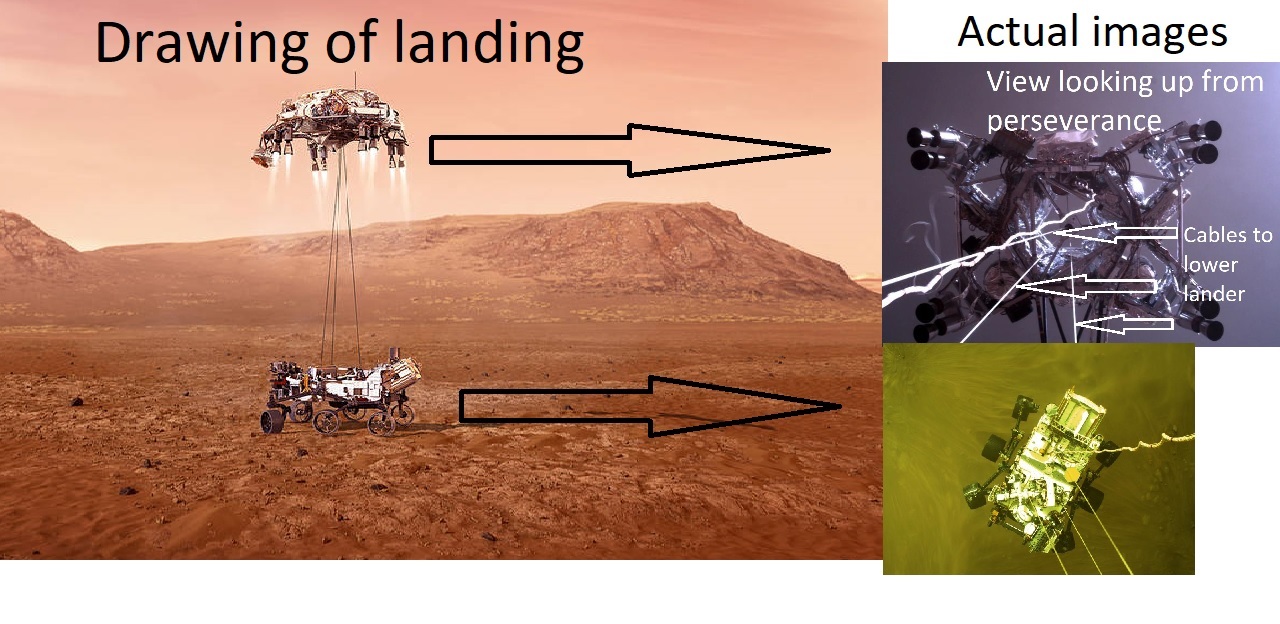Mars Perseverance Rover
Vice Chair of Marspedia &
Education Director for RedPlanetPen.com
It is licensed under Creative Commons BY-SA 3.0 and may be freely shared, but must include this attribution.
NASA’s Mars Perseverance Rover (formerly Mars 2020) launched on July 30, 2020 and landed on Mars on February 18, 2021. The landing site is Jezero Crater at the coordinates 18.38°N 77.58°E, at nearly the same longitude as the Viking I lander in 1976. Perseverance has four major goals. The first goal is to determine whether life ever arose on Mars, the second goal is to characterize the climate of Mars, third is to characterize the geology of Mars, fourth and most importantly to prepare for human exploration of Mars.
Perseverance, nicknamed Percy, was once thought of as a clone of MSL Curiosity, which landed in Gale crater in 2012. Some of the systems are the same and some have been updated with current technology. The 2020 rover is over 150 kg heavier than the MSL rover, weighing in at 1,025 kg. Perseverance will utilize the same landing system as Curiosity, the skycrane, which is enhanced with updated technology such as terrain relative navigation. This system will help Perseverance avoid landing in a dangerous area. Another new technology is the system called range trigger, which tells the parachute when to open in order for the rover to land in the desired landing spot. This technology saves time, as previous rovers had to land in a flat area and later drive to the more interesting targets. Perseverance has updated titanium wheels which include cleats and spokes as scientists discovered that Curiosity’s wheels were being damaged by the sharp rocks. The wheels for Perseverance were redesigned to withstand damage from the sharp rocks.
An objective of the Mars 2020 rover is to determine whether life ever existed on the Red Planet. Jezero Crater is of particular interest due to the geological features present. This crater has remarkable geological layers that have been exposed by an ancient impact. This makes for an interesting target to search for fossilized life on Mars. Jezero Crater seems to have once been home to a large lake and rivers. The features at Jezero Crater include clays and minerals consistent with the presence of liquid water for long periods of time. This is an important indicator that the area was once habitable.
Instruments
The Perseverance Rover is equipped with 23 cameras, each with different specifications and purposes. One of the cameras, called the up-look camera, will record the descent stage of the rover and the descent stage camera will record the landing. The mast of Perseverance includes two Navcams to help the rover team with navigation. On the front and rear of the rover are additional cameras for hazard detection, called Hazcams. For the first time a rover on Mars will be outfitted with microphones. One microphone is on the landing package and the other is housed on the Super CAM instrument. The Super CAM microphone will allow scientists to hear the sounds of Mars and the landing microphone will allow scientists to analyze entry, descent, and landing.
A helicopter named Ingenuity will be attached to the underbelly of the rover. Ingenuity is a semi-autonomous experimental helicopter that will receive commands from Perseverance. Ingenuity is designed to fly in the Martian atmosphere, with 1% of the air in Earth’s atmosphere. The helicopter weighs less 1.8 kgs and the body is about the size of a baseball. It has twin counter rotating blades. The engineering plan consists of the blades rotating fast enough, 3,000 rpm, to be able to sustain flight in the thin Martian atmosphere. The Ingenuity helicopter includes solar cells to recharge batteries, cameras, radio frequencies to communicate with the rover, lightweight flexible legs, aerogel insulation and a heater to keep the instruments warm in the cold atmosphere. The plan includes at least five attempted flights. The helicopter is a technology demonstration test. The aim is to determine whether controlled flight is possible in the thin Martian atmosphere. The lithium-ion batteries will allow for one 90 second flight per charge. In that 90 seconds, the helicopter may be able to reach a range of 300 meters. This is a precursor for future drone missions on Mars. Drones would be able to take data on a much larger scale in a much shorter period of time than rovers.
The robotic arm of Mars 2020 is 2.1 meters long and is articulated with five joints, in order for the instruments to maneuver and assist in research. On the end of the arm is a turret which is home to several instruments. The arm has an instrument called the Gaseous Dust Removal Tool (GDRT) and the drill. The tools found on the turret are SHERLOC, WATSON, and PIXL.
The Planetary Instrument for X-Ray Lithochemistry (PIXL) is an X-ray spectrometer which allows for the detection of biofilm. Microbial organisms leave behind these remnant microfilms that can later be detected by spectrographic analysis. On the robotic arm is an instrument called PIXL which will allow for more detailed chemical analysis. PIXL has “an X-ray fluorescence spectrometer that will also contain an imager with high resolution to determine the fine scale elemental composition of Martian surface materials. PIXL will provide capabilities that permit more detailed detection and analysis of chemical elements than ever before.” (NASA)
The Scanning Habitable Environments with Raman and Luminescence for Organics and Chemicals (SHERLOC) is located on the robotic arm, will differentiate between organics that are native to Mars or that may be contaminants brought to Mars by a meteorite. SHERLOC utilizes an ultraviolet laser spectrometer to determine the make-up of surface features that may indicate the presence of ancient microbes. SHERLOC will be tasked with astrobiological analysis by determining habitability of the environment and the aqueous history of any samples taken. A key piece of evidence SHERLOC is tasked with finding are the biologically necessary elements that have been discovered on Mars by the Curiosity Rover, C, H, N, O, P, S. These are the six main ingredients found in all life on Earth. The instruments are also going to investigate whether biosignatures are preserved in the rocks in minerals being examined.
Several small samples of astronaut space suits will be housed inside the SHERLOC. This is the first time material from space suits will be sent to Mars. These samples will be examined to determine how the harsh Martian environment will affect the materials.
The Wide-Angle Topographic Sensor for Operations and eNgineering (WATSON) is also located on the robotic arm and can be oriented toward the other instruments to image them and assess any issues that may be occurring. This instrument works with SHERLOC to take extreme close-up images of the mineralogy. This allows for overlays of the composition of different minerals between the SHERLOC and WATSON results. Outcomes of the collaboration between instruments will include the discovery of how the minerals in Jezero Crater formed and overlap. Data can also be combined with PIXL data in order to determine if evidence of ancient microbial life may be present.
The main mission of ‘Percy’ is to seek signs of ancient life on Mars and to collect and store a cache of rock samples to possibly return to Earth. The robotic arm of Perseverance has a percussive coring drill that will retrieve geological samples. The rover also has a caching system for samples drilled a few centimeters below the surface. NASA has provided an animation of this process. Perseverance will collect approximately 20 samples with a size of 1.3 cm by 6 cm, leaving behind drill holes of 2.7 cm in diameter. A camera called CacheCam will monitor the cache system and samples collected. This system will keep a photo record of each sample and how and where they were collected. The samples will be stored on the Red Planet until, at a later date (to be determined), the cache will be retrieved and sent back to Earth. The proposals for retrieval include a smaller lander with a rocket that will launch the samples to an orbiter around Mars which would then return the samples to Earth. The retrieval plan has not been finalized.
The mast of Perseverance stands two meters above the surface of Mars and includes the SuperCam, Mastcam-Z, and MEDA. The SuperCam is the newest iteration of Curiosity’s ChemCam. SuperCam is a suite of instruments located on the mast of the rover, including cameras, lasers, and spectrometers. The instruments can identify harmful particles in the Martian dust. This is important for future manned missions. SuperCam has a more powerful laser than ChemCam that can vaporize portions of rocks from about 6 meters away. The spectrometer then analyzes the vapor to determine whether the minerals were formed in the presence of liquid water or contain organic molecules. The instruments can identify samples as small as a pencil point as far away as 7 meters. The SuperCam is “an instrument that can provide imaging, chemical composition analysis, and mineralogy. The instrument will also be able to detect the presence of organic compounds in rocks and regolith from a distance.” (NASA)
Perseverance has two stereoscopic Mastcam-Z cameras, which are enhanced versions of Curiosity’s Mastcam. The cameras will assist with determining the mineral content of the surface of Mars. Mastcam-Z is “an advanced camera system with panoramic and stereoscopic imaging capability with the ability to zoom.” (NASA) This instrument has three main goals. The first is to observe the “landscape geomorphology, processes, and the nature of the geologic record.” (NASA) The next is to observe astronomical events and assess atmospheric conditions. Lastly, Mastcam-Z is tasked with “provid[ing] operational support and scientific context for rover navigation, contact science, sample selection, extraction, and caching, and the other selected Mars-2020 investigations.” (NASA)
A goal of Perseverance is to characterize the climate of Mars. This information is of great importance to allow for future human explorers to be able to predict climate and weather patterns more accurately. The Mars Environmental Dynamics Analyzer (MEDA) is a set of sensors that will provide measurements of pressure, temperature, windspeed, relative humidity, and wind direction. MEDA will also measure the size and shape of atmospheric dust particles. This information will help scientists plan for human missions to Mars by knowing how to plan for the habitats and pressurized suits and their accompanying filtration systems.
The body of perseverance includes other instruments including RIMFAX and MOXIE. The Radar Imager for Mars’ subsurface eXperiment (RIMFAX) has a ground penetrating radar (GPR) system that can resolve objects as small as a few centimeters. This is the first time GPR will be used on the surface of another planet. This instrument is capable of detecting ice or salty brines. It has been speculated that salty brines may be an excellent habitat for extant life on Mars. RIMFAX will also study the geology of Mars, similarly to its many predecessors. ‘Percy’ will study the geological record of the Jezero Crater. If the sequence of the age of the rocks in the area can be determined, it will help decipher the sequence of events that occurred throughout the history of the Red Planet. The instrumentation on the rover will examine the make-up of the rocks and minerals in order to determine whether water or organic material was present in the area.
The most important goal of the Perseverance Rover is to prepare for a human mission to Mars. The Mars Oxygen ISRU Experiment (MOXIE) is a new instrument on Perseverance that’s purpose is directly associated with a human mission. Mars has an abundance of oxygen in the form of carbon dioxide. MOXIE will intake the CO2 and heat it up to 800o C. When the molecules are heated, they separate into carbon and oxygen. The conversion of Martian CO2 into O2, will pave the way for a human mission to Mars. The goal is to make rocket fuel for a human return mission to Earth. The implications are also relevant to O2 generation for human life support systems. MOXIE is “an exploration technology investigation that will produce oxygen from Martian atmospheric carbon dioxide.” (NASA)
Drawing and actual pictures of Perseverance actual landing on Mars
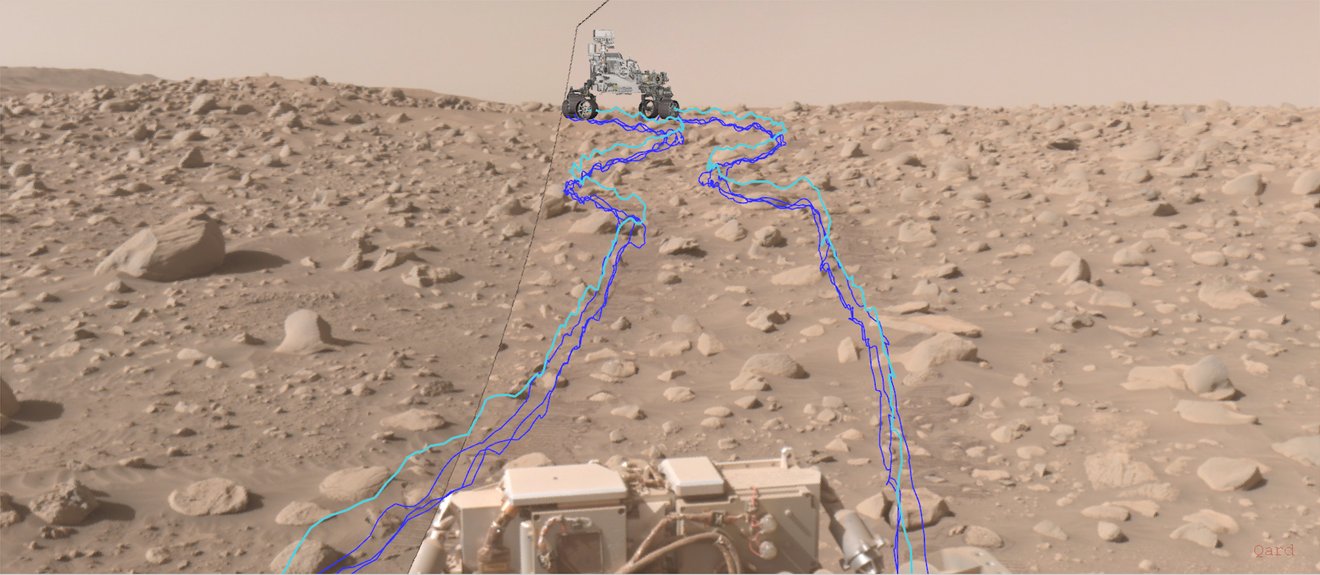
References:
https://mars.nasa.gov/mars2020/mission/overview/
https://mars.nasa.gov/mars2020/mission/science/
https://mars.nasa.gov/news/8678/the-detective-aboard-nasas-perseverance-rover/
https://www.nasa.gov/perseverance
https://mars.nasa.gov/mars2020/spacecraft/instruments/mastcam-z/for-scientists/
https://www.youtube.com/watch?v=W0Ru6hsRZcI
https://www.youtube.com/watch?v=jwPZ28A36_0&t=86s

